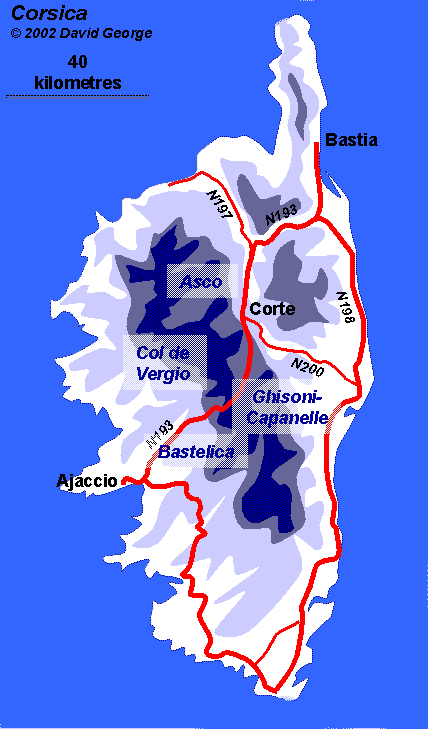
Ski Areas > Corsica
Corsica is a small mountainous island situated slap bang in the middle of the Mediterranean sea close to Italy and Sardinia. It was the birthplace of Napoleon at a time when Corsica was independent of France. Today it boasts French supermodel Laetitia Casta and the cute singing lolita Alizee amongst its inhabitants.
The snow is usually very good above 1800 meters and can be found down to 1400 meters depending on the conditions. Skiing is possible from December through to April but you can only rely on snow after mid-January. There are currently three downhill ski areas on the island and always talk of projects of creating a real ski resort in the style of the Southern Alps. In years past ice used to be transported all year long from peaks around Vizzavona to thirsty drinkers in the cafes of Ajaccio. In 1934 the worst avalanche of this century occurred on the slopes of Castagniccia at only 700 meters altitude, sweeping through the village of Ortiporio and killing 37 people. These days the winter snows are somewhat less sure and an active and sometimes violent independence movement restricts any major tourist development, sometimes with high explosives!
The regional ski committee has a long standing plan to develop a ski station in the bowl at La Lattiniccia on the road pass close to Corte The proposal is for 30km of pistes between 1550 and 2400 meters altitude with the possibility of doubling the area in the future. The total cost of developmentis estimated at 12.5 million including necessary artificial snow cover. Presumably a large part of this money would come from European funds. Whether this project will ever be realised remains to be seen.

Before you get ideas of snow, sex and sun in the isle of savage beauty you should be aware that Corsica is basically a 2,500 meter high rock surrounded by huge expanses of ocean. As such it catches every weather system as it tracks across Europe. Off piste skiers and freeriders need to carry an altimeter, maps and compass and know how to use them. Tragic accidents are all too common. You can start out in warm spring sunshine with the sea glistening far below only to have the mercury and barometer plunge faster than an Ajaccio babe's neckline. In June 2002 four walkers set out in brilliant sunshine to cover part of the GR20 crossing the Cuscionu plateau. At around 2000 meters there is little more shelter than the ruins of an ancient refuge. Just 20km from the sea this is still remote, a mobile phone has difficulty to seek out a signal. A storm broke, they were trapped, one died of hypothermia and the others were lucky to escape with their lives. They were caught a mere couple of hours from some small farms but couldn't find their way in the storm. Two years earlier there was snow in July, dozens of people were evacuated by helicopter from the refuge de Petra Piana, some wearing shorts and tennis shoes.
In the winter violent storms are somewhat less frequent but the constant wind drives the snow into potential slab avalanches. Powder is rare due to the wide daily temperature variations which leads to its rapid transformation. This stabilized snow-pack is favourable to extreme skiing. Fog is also not uncommon and the temperature variation forms black-ice which is the frequent cause of accidents.
